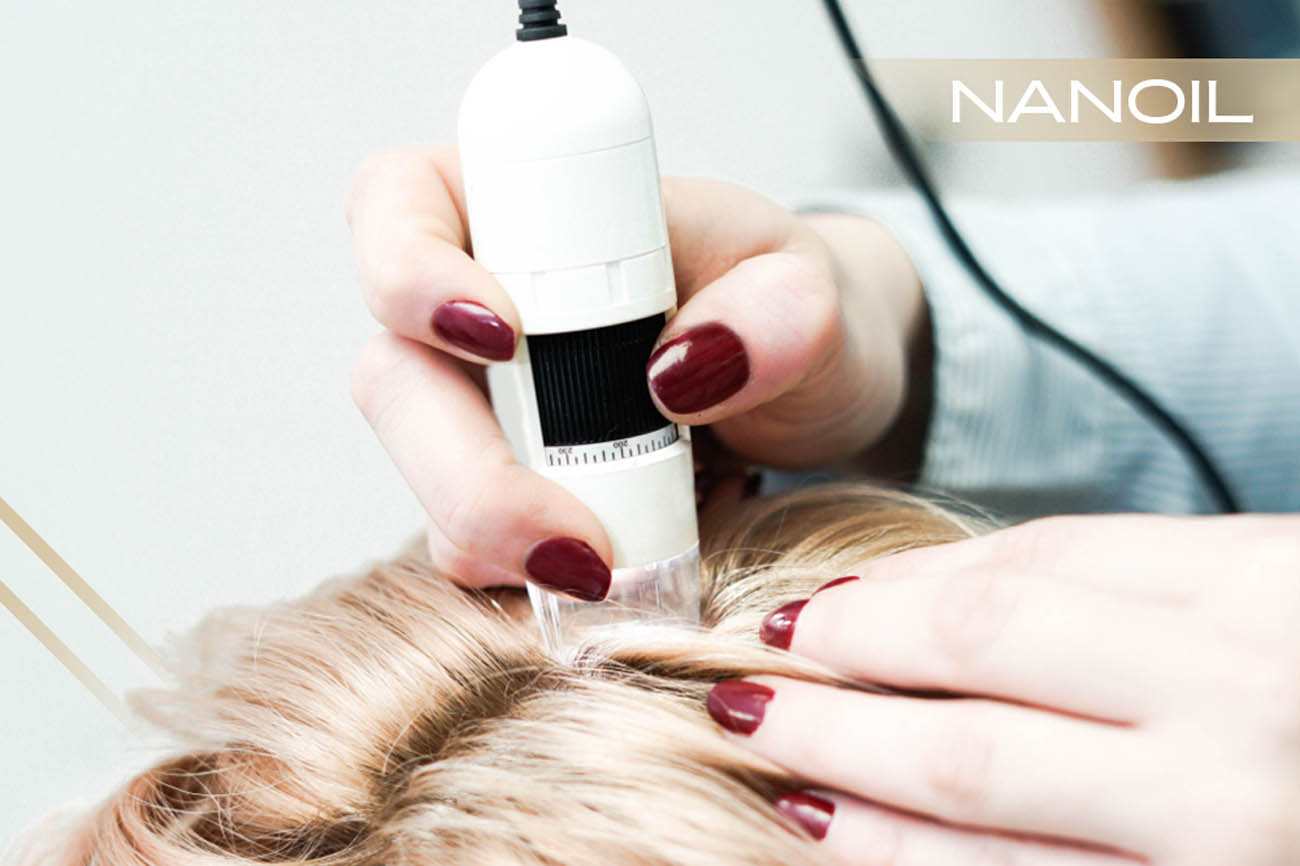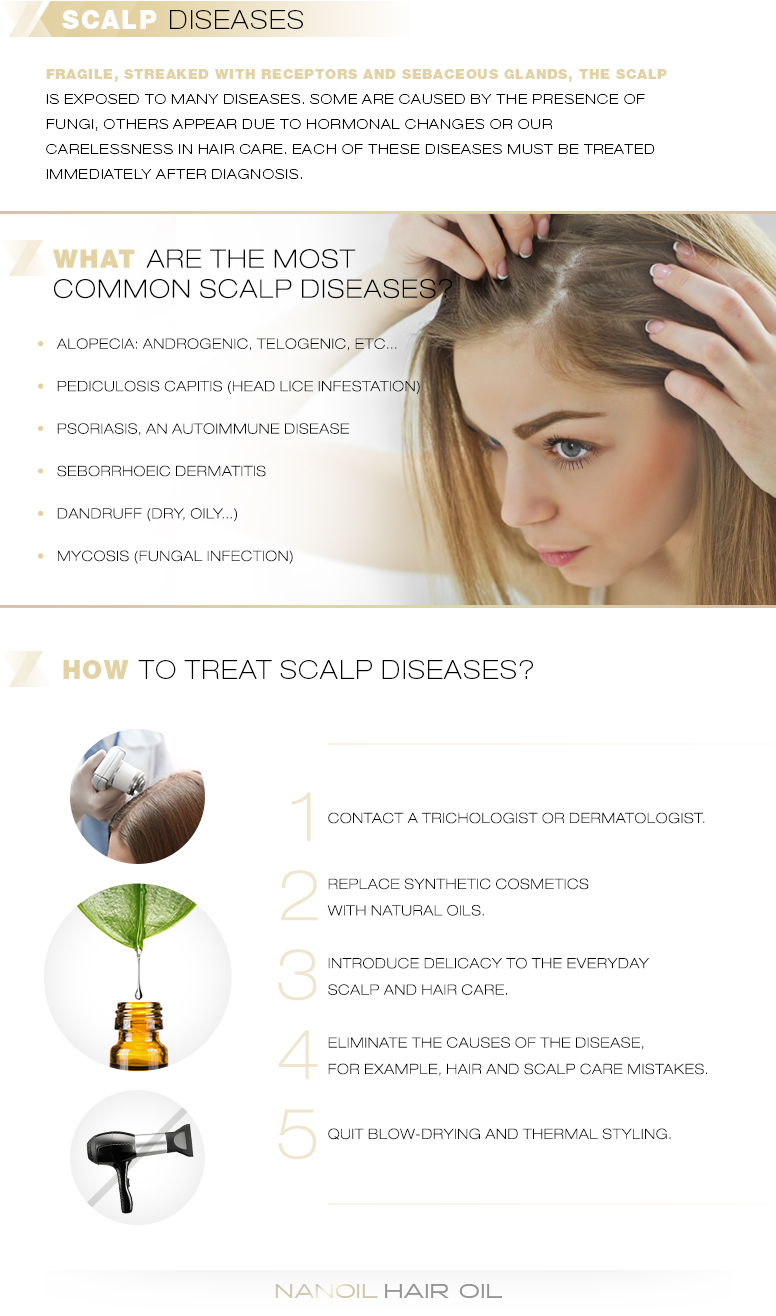- NANOIL Products
- Oils
- Face serums
- Hair masks
- Shampoos
- Hair conditioners
- Hair styling
- Hair Porosity Test
- Blog
- Contact

Unpleasant scalp itching and hair loss are problems that are often caused by scalp diseases. Get to know the most common illnesses that can also happen to you, and learn how to treat them effectively to enjoy healthy and beautiful hair.
Scalp diseases are becoming a common health problem. They affect people of all ages and are not gender-dependent. They appear because the scalp is quite unusual and definitely different from other parts of our skin. It is easy to sensitize it, it is an ideal environment for the development of various infections.
One of the scalps' characteristic features is a large number of receptors and even larger amount of secreted sebum in comparison to other parts of the body. The hairy scalp is quite a warm environment - an ideal place for the development of fungi and microorganisms.
In addition, there is definitely greater scalp sensitivity - congenital or appearing as a result of adverse external factors. This feature makes it very easy to irritate the scalp and difficult to cure inflammation.
If you add poor hydration caused by frequent use of highly cleansing and drying shampoos, as well as the lack of proper nutrition and allergies ... it turns out that the scalp is a part of our skin that's the most susceptible to various diseases.
We already know that the scalp can be exposed to all kinds of illnesses. What are they in particular? It is worth learning the most common scalp diseases, so in the future, it will be easier to determine a possible problem and introduce appropriate treatment.
The most common scalp conditions include: fungal infection, seborrheic dermatitis, scalp psoriasis, dandruff, pediculosis, and alopecia with varied courses.
The methods of treatment depend on the disease we must deal with. Some products will help overcome dandruff, while others will serve to get rid of lice. Each case is worth consulting with a trichologist or dermatologist to choose the right methods of treatment.
However, you can distinguish a number of rules that are worth incorporating in the daily care in all of the cases. Diseases of the scalp significantly weaken and irritate it, which is why a good solution is to alleviate these irritations and provide the skin with everything that is needed - vitamins, minerals, fatty acids, humectants. How to do it?
When it comes to oils, it is worth remembering that, if they are used reasonably and in accordance with the recommendations, they will help to care for the health of the hair and scalp. Choosing the right natural oil is the right step in daily care because it supports the treatment of scalp diseases. The most recommended oil for the scalp, which strengthens hair roots, prevents hair loss, cures dandruff, reduces oily hair, and accelerates its growth, is castor oil.

PEDICULOSiS CAPITIS (Head lice infestation)
This is a problem that reminds many people of their school years. Apparently, schools are the easiest place to get infected with lice, a disease for which human louse is responsible - a small insect that feeds on blood from the scalp. The first step in the treatment of head lice is, unfortunately ... hair cutting. Subsequently, pharmacotherapy should be used, e.g. in the form of permethrin shampoos. One of the effective gadgets that help you get rid of lice is an electronic comb. However, of course, you can also reach for homemade ways to get rid of lice (eg essential oils, vinegar, rosemary rinses) and ensure proper hygiene.
MYCOSIS (Fungal infection)
Excessive hair loss, as well as flaking, itching, and burning, are the first symptoms of scalp mycosis. The reason for this are fungi, which especially attack people with reduced immunity. Importantly, fungal changes affect not just the skin but also the hair itself. In the case of this disease of the scalp, it is very important to react immediately after discovering the first symptoms, because this way, the treatment of mycosis will be easier.
The mycosis of the scalp has several varieties:
Accurate diagnosis is the first step to introducing proper care and treatment. It is necessary to use preparations with fungicidal components (usually oral), sanitizing ointments, as well as shampoo with ketoconazole. The scalp's fungal infection also requires frequent trimming and replacement of all existing hair accessories such as brushes, combs, etc.
DANDRUFF
When discussing scalp diseases, it is impossible not to mention dandruff. It is an uncomfortable condition that, unfortunately, affects more and more people. Sometimes it is a one-off problem, but it can have a recurring character. The causes of dandruff are also different: from genetic conditions, stress and hormonal disorders, to mistakes in daily care and ... fungi!
There are several types of dandruff:
The easiest way to get rid of dandruff is to use anti-dandruff shampoos, but it is worth remembering that they can be addictive. So how do you treat dandruff? It's good to know that dandruff hair care is not an easy task at all. My word of advice: it's best to go to the doctor.
SEBORHORREIC DERMATITIS
It is a scalp disease often mentioned as a type of dandruff. Why? Because one of the symptoms of seborrheic dermatitis is strong skin exfoliation. The biggest problem resulting from this disease is chronic inflammation with a tendency to recur, as well as erythema and crusts forming on the surface of the skin. Interestingly, seborrheic dermatitis is seasonal - it's more likely to appear in autumn and winter. What's more, there is no single cause of SD - the disease is the result of many changes including hormonal, immunological as well as external (fungi, diet, hygiene).
PSORIASIS
One of the most serious scalp diseases is psoriasis. This is an autoimmune disorder, which means that the immune system attacks other cells in the body. Scalp psoriasis is manifested by disturbed processes of renewal and exfoliation of the epidermis. The skin cells multiply too quickly, the epidermis grows, and then it strips and forms large scales. The symptoms of psoriasis cannot be mistaken for any other. Unfortunately, the treatment of this condition is very difficult - you cannot use any oily and thick preparations on your hair, only drugs prescribed by a dermatologist and special shampoos.
ALOPECIA
Alopecia is another serious scalp disease. Of course, this is mainly about hair loss in far too large and uncontrolled quantities. The most common causes of baldness include stress, iron, and folic acid deficiency, pregnancy, chronic illness, taking medicines, and hormonal disorders, e.g. hypothyroidism.
Alopecia may have several forms:
Antibiotic therapy is the most common treatment for alopecia. You can also use hair ampoules, herbal scalp lotions, face masks and natural oils that, when massaged into the scalp, restore the natural activity of hair follicles and stimulate the work of hair bulbs.
Important! Every single scalp disease requires consultation with a trichologist or dermatologist because only a specialist can accurately determine the type, cause, and provide the right method of treatment of the disease!
Leave your email address and we ll notify you when the product is back in stock.
Comments: #0